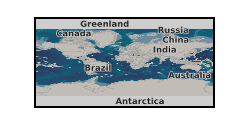Fault gouge
Type of resources
Topics
Keywords
Contact for the resource
Provided by
Years
Formats
Update frequencies
-

The data are from a suite of friction experiments performed on 3 different grain size quartz gouges (5, 15 and 30 microns). The quartz gouge layers were sheared under a range of effective normal stresses (40-120 MPa), at a displacement rate of 1 micron/s, and the evolution of shear stress was monitored with increasing displacement (up to a maximum displacement of 8.5 mm). The gouges typically exhibit a transition from stable sliding, where the gouge layers shear in a continuous smooth fashion, to unstable sliding with displacement, where the gouges exhibit stick-slip behaviour. The transition from stable to unstable sliding occurs more efficiently in fine-grained quartz gouges and is promoted by high effective normal stresses.
-

The data are from a suite of friction experiments performed on simulated fault gouges comprised of clay-quartz mixtures, sheared in a direct-shear arrangement. Some experiments were performed on gouge layers comprised of adjacent patches of kaolinite-clay and quartz (i.e. heterogeneous gouge layers), whereas others were performed on homogeneous mixtures of the two materials (i.e. homogeneous gouge layers). More information on the different types of experiment is provided in the accompanying metadata for this dataset. The relative proportions of clay and quartz were varied in different experiments. All experiments were performed at an effective normal stress of 40 MPa. The sliding velocity was stepped between 0.3 and 3 microns/s every 1 mm of displacement to calculated the rate-and-state friction parameter (a-b). The evolution of shear stress was monitored with increasing displacement (up to a maximum displacement of 8.5 mm).
-

This information details the method of calculating dilatancy from pore volumometry measurements. In the velocity step tests, an initial shear enhanced compaction phase drastically reduces the sample pore volume until the sample yields. After the sample yields, the pore volume continues to decrease but at a lower rate of decrease. The imposed velocity steps cause compaction or dilation of the sample material that is superimposed on this overall compaction trend. Pore pressure is held at a set point in all tests and any volume changes in the control system are assumed to correspond directly to changes in pore volume in the sample. The method here is aimed at producing quantitative, reproducible values for dilatancy from experimental data. The script fits a polynomial function to all the volume data to give the overall trend of the shear enhanced compaction. The data position of the start of the velocity step of interest is entered manually into the function. When dilatancy occurs on a step change in velocity, this is not immediately recorded using volumometry, as the permeability of the sample will produce a transient response as pore fluid pressure equilibrates between the sample and the pore fluid pressure system. To discount time effects, every velocity step was processed with a ‘time_dep’ phase for the first 100µm of displacement after the imposed velocity step change. Using the values for ‘vel_step’ and ‘time_dep’, the volumometry data are split into separate matrices incorporating time and volume preceding and following the velocity step change. A linear regression model fits a polynomial curve to the pore volumometry data and returns the coefficient of determination (R2) for the fit of the model. The shear enhanced compaction phase prior to yield is included in the fit. The code incrementally adds the value entered for ‘step’ to the data in the velocity step of interest. This ‘step’ value is a positive or negative value depending on whether the velocity has increased or decreased, respectively. A new linear regression model is then fitted to the whole dataset and if the R2 value has increased, the code will continue to loop to add the value of ‘step’ to the pore volume data. It concludes when the R2 value reaches a peak and begins to decrease, as the fit is no longer improving. We assume at this point that the effect of the dilatancy due to the velocity step has been removed, and the cumulative sum of the ‘step’ values is equivalent to the dilatancy. As the loop goes one iteration past the optimum R2 value, the code reverts to the previous set of values with the best R2 value. In experiments with multiple velocity step changes, the code needs to retain the previous corrections of the data. The function ‘pf_correct’ is used to correct the velocity steps that have been previously processed. The values for ‘vel_step’, ‘time_dep’ and the returned value of ‘offset’ need to be given in the inputs for ‘pf_correct’.
-

The data are from a suite of friction experiments performed on simulated gouges from the Nankai Trough (Japan). The simulated gouges were prepared by crushing cuttings of Nankai accretionary sediments collected during Integrated Ocean Drilling Program (IODP) Expedition 358. The cuttings were crushed to produce a powder (i.e. simulated gouge) with a grain size of >125 microns. These simulated gouges were sheared under a range of effective normal stress (10-75 Mpa) and pore-fluid pressure (5-75 Mpa) conditions while the sliding velocity was stepped between 0.3 and 3 microns/s to calculated the rate-and-state friction parameter (a-b). The Nankai gouge are strongly rate-strengthening and become more rate-strengthening (i.e. more frictionally stable) at elevated pore-fluid pressure. In contrast, varying the effective normal stress has minimal effect on the frictional stability of the gouges.
 NERC Data Catalogue Service
NERC Data Catalogue Service